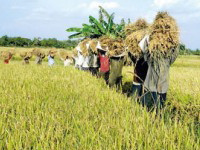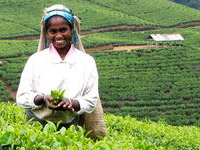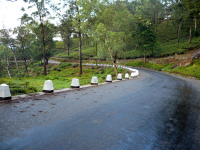
Since the inception of the Provincial Council system in Sri Lanka, the Central Provincial Council has been able to take giant leaps to development milestones. The province has been a central economic location from the time when British ruled. The Central Province provided the third highest contribution to the GDP, maintaining its relative position compared to 2009, and managing to increase its GDP contribution to 10.0 per cent in 2010 (Central Bank). By taking advantage of its unique geography, the Central Province contributed 18.2% of the total in the agricultural sector in 2010 in Sri Lanka. Per capita income of Central Province is Rs 208,000 and it comfortably lies somewhere in the middle of the income continuum, manifesting fair income disparity.
 The province also holds a certain significance to the export sector, especially for the much sought after commodity "Ceylon Tea". The Central Province is identified with its broad ethnic diversity; Sinhalese amounts to 65.35%, Indian Tamil amounts to 19.92%, Sri Lankan Moors amounts to 9.20%, Sri Lankan Tamil amounts to 5.05%, and Burgers amounts to 0.15%. The Council has been able to successfully address diverse and specific needs of these segments. In 2001 the population of the Central Province was estimated to be 2,423,966, which represented a 12.97% of the total population making the Central Province the second most populated in Sri Lanka. This presents an important implication in terms of administration and financing of the province as a whole. Kandy is the most populated district in the Central Province, accounting to a population of 1,279,028 individuals, followed by the Nuweraeliya District of 703,610 individuals, and the Matale District of 441,328 individuals according to national census carried out in 2001.
The province also holds a certain significance to the export sector, especially for the much sought after commodity "Ceylon Tea". The Central Province is identified with its broad ethnic diversity; Sinhalese amounts to 65.35%, Indian Tamil amounts to 19.92%, Sri Lankan Moors amounts to 9.20%, Sri Lankan Tamil amounts to 5.05%, and Burgers amounts to 0.15%. The Council has been able to successfully address diverse and specific needs of these segments. In 2001 the population of the Central Province was estimated to be 2,423,966, which represented a 12.97% of the total population making the Central Province the second most populated in Sri Lanka. This presents an important implication in terms of administration and financing of the province as a whole. Kandy is the most populated district in the Central Province, accounting to a population of 1,279,028 individuals, followed by the Nuweraeliya District of 703,610 individuals, and the Matale District of 441,328 individuals according to national census carried out in 2001.
Proposed actions which are explained in detail in the following chapters have been laid on fertile socioeconomic factors that have been described above. The data presented below in a time span of three years from 2009, provides a better insight into the Central Provincial Council's past performance and hence bestow credible evidence to prove its capability in achieving future development targets.
The Department of Local Government
|
District
|
Roads Developed (Km) |
No. of Sanitary Facilities |
No. of Parking Faclities |
Training AW. Programs |
||||||||
|
2009 |
2010 |
2011 |
2009 |
2010 |
2011 |
2009 |
2010 |
2011 |
2009 |
2010 |
2011 |
|
|
Kandy |
286.5 |
641.1 |
294.6 |
179 |
211 |
172 |
0 |
4 |
11 |
|
|
|
|
Matale |
71.6 |
122.2 |
73.4 |
2 |
3 |
7 |
0 |
0 |
0 |
29 |
54 |
352 |
|
Nuwaraeliya |
34 |
35 |
45.5 |
16 |
1 |
58 |
2 |
0 |
29 |
|
|
|
|
TOTAL |
392.1 |
798.3 |
413.5 |
197 |
215 |
237 |
2 |
4 |
40 |
29 |
54 |
352 |
 The year 2010 was an outstanding year for road development activities carried out by the Department of Local Government. In 2010 alone nearly 800km of roads were developed out of which more than 600km constructions were carried out in the Kandy District. During 2009-2011 1600Km of roads were developed. The target is to add another 1500Km of roads to the provincial road network by 2016. Much of the work was done during the last three years in the Kandy District. More than 500 sanitary facilities were established in the Kandy District during this period.
The year 2010 was an outstanding year for road development activities carried out by the Department of Local Government. In 2010 alone nearly 800km of roads were developed out of which more than 600km constructions were carried out in the Kandy District. During 2009-2011 1600Km of roads were developed. The target is to add another 1500Km of roads to the provincial road network by 2016. Much of the work was done during the last three years in the Kandy District. More than 500 sanitary facilities were established in the Kandy District during this period.
Matale and Nuwaraeliya Districts needs further attention with only 87 facilities being developed in the last three years. This three-year time period includes 46 parking facilities in Kandy and Nuwaraeliya. No parking facilities were established in the Matale District. Furthermore the department plans to add 50 three-wheeler parking facilities in 43 local government authority areas. There is a progressive increase in the number of training programmes conducted by the department in the Matale District. No training has been carried out in the other districts in the province.










